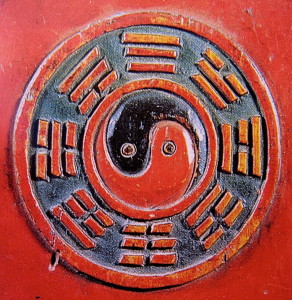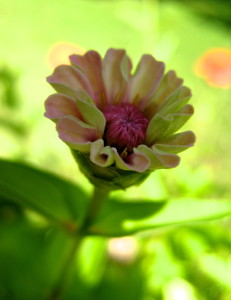
– Photo by Jan Ketchel
Tao is circular. Tao is wholeness. Tao is returning always to Tao. But Tao is also instinctual, knowing when to leave the circle, when to step outside the self and interact in the world. Nature is Tao, but nature is sometimes violent, yet it is still Tao. In Tao, in nature, everything returns to balance and harmony after the necessary aggressive deed is done.
To be in the Tao is to learn to flow, but also to be alert. If we were hermits, living in a cave far from others, our daily lives would be quite different from the lives of people living in a busy metropolis. But even so, we would have to remain alert to what was going on around us. We would have to be in harmony with nature. Our existence would be dependent upon and pretty much ruled by our environment, yet we might not have to ever be aggressive in the way that worldly people often have to be aggressive.
Sometimes, Chuck and I have what we call “monastery days.” On such days, we stay calm. We stay in our house, on our property, or perhaps we take a quiet walk around the neighborhood. We eat simply. We meditate, read, and go inward. We stay in the Tao. We use such days to contrast the busyness of life, giving ourselves respite, as we sit at the center of the circle of Tao.
I used to be a runner. Not only did I run for exercise, but I tended to run all the time; up the stairs, down the stairs, to my car, from my car. I’d do everything at a fast pace, trotting along. I had a lot of energy, but I was also running from a lot of stuff back then too. Now I don’t do that as much. Sometimes when we walk, Chuck will put his hand on my arm. I know this means “slow down.” And then I notice that I was going too fast, right out of the Tao of the day, out of the Tao of us.
When I walk alone, I tend to walk faster than we do as a couple, but I know this is okay. When I am alone, I’m in my own Tao and it’s different from the Tao of Chuck and Jan as a couple. But being a couple means being flexible, not being overpowering or overpowered, but finding what works between the opposites, the middle ground—a great opportunity to practice what it means to be in Tao! It can be a struggle, but in the give and take of relationship one learns the lessons of give and take in all relationships, whether they are inner or outer.
Sometimes, as a couple, we are very calm and sometimes we are not. Sometimes, as a solo journeyer, I am very calm too, but I usually try to flow with where I am. I’ve worked hard to be aware of the energy around me, to read it and be in it. As I ask myself to be in the Tao of the day, I go within and check on where I am. I feel my own Tao and try to align it with the outer Tao, try to stay in synch. It can be another challenge, but it’s also another lesson in relationship, relationship to the world, other, and to self. Sometimes it’s appropriate to be in the calm Tao, sometimes it can get you in trouble if the Tao around you is moving at a hearty pace.
We can’t really separate ourselves. Even on our monastery days, Chuck and I know that we might be interrupted. It’s rare that we do not have something outside needing us, but we allow and flow with what comes. Our circle is sacred, but there is compassion and understanding in that circle, there is awareness of other, of world. To be in Tao is to be appropriate at all times.

Sweater designed by me, knitted by Fanny on her machine, circa 1977
– Photo by Jan Ketchel
Back in my twenties, I had a friend in Sweden who bought a knitting machine. It was a long contraption that she could string four different colors of yarn into and knit with. She made mittens, hats, scarves and sweaters and sold them at various boutiques and outdoor markets. Even though she knitted on a machine—cutting knitting time down to a minimum, considerably upping her production—her goods still had a handmade quality to them. She loved to knit by hand, but she needed to make a living, and so she chose to go outside of her normal world and become a little more commercial. It required an aggressive move on her part, but it worked. She ended up with a very successful business.
We shared a large studio together with five other artists of various skill sets, artisans, performers, and illustrators and painters alike, all of us doing our thing, commercial or otherwise. We existed for several years quite harmoniously in a bustling environment, all of us successful. It was very Tao. The energy of the time, of the people, of the place we inhabited all came together in alignment. But the perfect Tao of that time came to an end. At the same time that I decided to return to America, the lease was up. The landlord wanted the space for himself. Other people in the group had other opportunities coming in, offers to move on too. The knitter became a massage therapist. The signs were there that we could not hold together anymore.
That too is being in the Tao, knowing when it is time to disassemble, time to shift, time to move on, time to move deeper into the circle of self, or deeper into the Tao of the outer world. Tao is knowing when it is time to let go and then following through and actually letting go. Tao is never stagnant.
When we are young, the outer world is our learning environment. We must leave our secure world of family, our dependent childhood and the comforts of the known, and go into the outer Tao. We must experience the wholeness of Tao if we are to become whole ourselves. We must walk hand in hand with others and discover what it means to give and to take, in all the many different situations and relationships that we encounter as we go through life.
Even in our traumatic experiences we are learning something important about life and Tao. If Tao is everything then Tao is sadness, violence, hatred, anger, abuse, pettiness, ignorance, and meanness too. If we are to return to the circle of Tao from which we all come, we must bring our recapitulated, fully assimilated experiences with us, for they are part of our wholeness and they too belong in our Tao of Self. Tao of Self means having no secrets, every part acceptable.
As we go inward, our experiences of having been outward are our greatest guides. If we do not know what we carry in our “inner” world then we will never be in Tao. Likewise, if we do not know the “outer” world and how it works we will never be in Tao either. Our first job is to prepare ourselves for life, secondly to live fully in the Tao of who we are in the world, and thirdly to bring all of our experiences inward, creating a whole self. Then we are ready to sit in the center of the circle of Tao. Then, like the hermit in his cave, our relationship to Tao will be harmonious with nature, because we have fully understood it.

As we do our inner work and gradually allow ourselves to evolve, we enter into the wholeness of ever-evolving Tao, into the nature of all things in balance but in constant flux as well. If we can learn to be flexible—as Chuck asks me to be whenever he silently puts his hand on my arm, signaling that I am not in “our” Tao—we soon find that it’s easier to be flexible all the time. Tao is flexibility.
Tao is everything, and so we are always in it. But it’s up to each of us to become consciously aware of it, of how we are in relationship to it, to other, to our work, to our dreams. Our dreams are already there, waiting in the circle of Tao for us to find them.
Greetings from the Tao of me,
Jan










